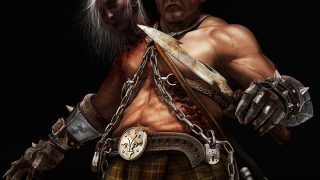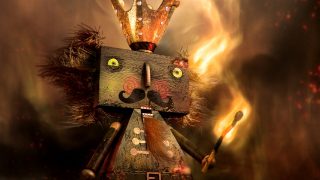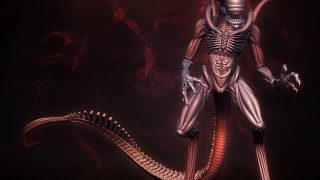
Making of the Hammerburst II
I will try to show you how I proceeded to get the Hammerburst II from “Gears of War 2” done. So I will try to explain my modeling, texturing, rendering and final compositing work flow for it.
|
Hello everyone! I will try to show you how I proceeded to get the Hammerburst II from "Gears of War 2" done. So I will try to explain my modeling texturing rendering and final compositing work flow for it. |
 |
| Okay! To have this model done with textures and a good render! In extreme production deadlines like here in Morocco. And of course if it’s you who does all the jobs. You must have in mind that you will need time also for rigging and animating your model for exemple when you have characters based projects. The modeling, UV mapping, texturing should go quite straight forward to save time for other tasks. So the more time you save the more you can deliver before the deadline and everybody is happy and everybody loves you. |
|
|
| First you need a concept that the customer gives you or you create yourself. Here we have a bad ass design by James Hawkins for “Gears of war 2” and they need that gun for the cinematic …NOW!…I’m kidding of course let’s say 3 days! So the first thing to do is start analizing the design… Is it a made of one block or multiple parts? If multiparts (or not) what’s the primitive that is the closest to each part shape? |
 |
| And we begin blocking the model (like blocking poses in animation) just with primitives. From now on you should know about modeling tools that let you add details to each primitive like extruding, beveling, weldding points together (don’t use that too much or you will end up with a messy mesh unless you know what you are doing) adding edge loops,selecting edge loops, selecting vertex paths! |
|
|
|
One advice you should have already knew about: 2) No triangles or n-gons but-you have the option of using triangles as you want if it’s in on a flat surface and you surely never will have to skin it over a rig ,so it won’t affect the look of your mesh! 3) Keep the mesh with as few polygons as yo can even if you are on high poly. This way you have more control over your model, tweaking is a lot easier with fewer vertex(but there is always lattices) and keep in mind that you will render it or someone else will take it for a render ! 4) Latices can help you achieve a certain look easily while keeping the topology of your mesh nice and clean. With that you can reshape million’s of polygon just like tweaking a cube. |
 |
|
Again for texturing you begin with the projection that matches the primitive shape you made that part with (cylindrical cubic spherical etc). But here you should select areas where these UV projection doesn’t work(textures looks streched) and give it a projection that matches it’s shape! You should have a "UV ‘ing" image (usualy a checker with colors and numbers) that helps you check how your projections work. Here is my trick that normally is bad habit I admit, but it allows me to win a lot of time for other tasks! Here I suggest to go to other texturing tutorials where you will learn about Bodypaint, Photoshop texturing techniques etc, but if like me you will be asked to do everything and don’t have time to spend a day for fine tuning your textures then let’s begin. I still suggest that you learn it the right way before doing it this way so we beginning with searching textures for materials that we would like to render: orange – pictures of an orange; banana – pictures of a banana |
 |
| Your render quality will go up or down depending on how you use the XSI’s render tree! and that’s before going on any mentay ray render options the phong material is intended to be used for metal! Simply plug’in a phong and giving it your texture as a diffuse with some reflections won’t work to achive a good looking metal so! let’s start. First we open the XSI’s render tree alt +7 we check our material by double clicking on the phong node! I always make the ambient color to complete black as I know that I will use final gathering in my final render and don’t won’t this object to emitte any light. Then I go the the specular decay and I always bring it’s value down so I have more specularity over the surface and that’s usualy wath happens on real metal surfaces. Then I import the texture that feel will work the best .plug it in the diffuse port .i start by isolating each part and begin testing how the render looks for it now that’s the funny part! I adjust the UV’s of my model to match the part’s that i want on the texture instead of the opposite which is making a Photoshop texture, that match the uv’s that you have done for your model. Once I finished that UV’s final adjustments for each part. I make a grayscale image of the diffuse texture inside of the render tree (forgot to mention that HSL ,contrat brightness can be adjusted inside of the render tree) and plug it on the bump of my shader just slight bumps on some parts some more on others adjust reflections how do they react with the bump until I have a fair looking render. I use an HDR on the environment and use two directional light one as main and other as a fill light. I use the physical sun shader with physical sky on both light. I just want to have a soft shadow effect and I also just love the tone that it adds to the render. |
 |
| I turn on final gathering raytraced shadows and and the primary rays to raytraced the frambuffer to michel 4, anti aliasing 0 2(0 3 is better but a lot slower), sampling contrast to 0,05 0,05 0,05 1 and the final tweaking begins. I setup the render to have two more passes that’s easy on Softimage ,a specular and a reflection then i make manualy an occlusion pass. |
|
|
| Then I make manualy an occlusion pass. | |
 |
|
| Now that we have our 4 render passes that we need we can start making our final image that looks so bad for now (just kidding..!) | |
|
|
|
| The specular pass will help us have the shiny glossiness that metal surfaces have in real life. How? Just composite it with a "screen" mode and apply a glow effects on it in after effects tweak it untill you have the look you want! The reflection pass can be used to have a blurred reflection which is extremely render time consuming if we make it inside of Softimage! A slight glow can be adde also to this pass as the reflection phenomona is about reflecting "light". Sometimes I prefer an overlay mode instead of screen for the reflection with decreased opacity composite the occlusion with a multiply mode you can some times decrease it’s opacity so it doesn’t hide your model details but only gives a slight soft shadow. Now we can tweak saturation contrast of the main render untill you have a look you are satisfied with. | |
 |
|
| You can also add slight grain to your image to give it a bit more of realisme. The background is simply a metal image(form the previous research of textures) and a drop shadow effect from after Fx | |
 |
|
| And final image you can find below | |
 |
|

Related linksEmail: yacinedelucia@yahoo.com Profile: yacinedelucia.3dm3.com |
About The Author
|




 I’m Yacine Adallal a 3D generalist, at first I was intended to be a musician or a programmer as I was studying computer sciences in France(Brest) and also music theory. I’m new to CG in general as i started to learn 3D in 2006 by a friend’s suggestion (I would like to thank him Younes Elharoussi specially and also Anas Rafiq). I got my first job in 2007. My first intention to say the truth was making money(and still lol..) but with time you start having fun on making some good looking stuff and the next time you just you want it to look even better and you find your self being addicted to that, and that’s a good thing if it happens to you,finally I would thank you for getting into here and reading about me if you have any question you can email me.
I’m Yacine Adallal a 3D generalist, at first I was intended to be a musician or a programmer as I was studying computer sciences in France(Brest) and also music theory. I’m new to CG in general as i started to learn 3D in 2006 by a friend’s suggestion (I would like to thank him Younes Elharoussi specially and also Anas Rafiq). I got my first job in 2007. My first intention to say the truth was making money(and still lol..) but with time you start having fun on making some good looking stuff and the next time you just you want it to look even better and you find your self being addicted to that, and that’s a good thing if it happens to you,finally I would thank you for getting into here and reading about me if you have any question you can email me.






